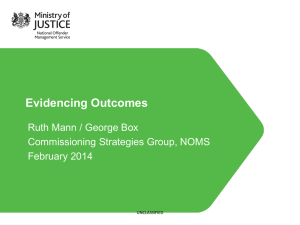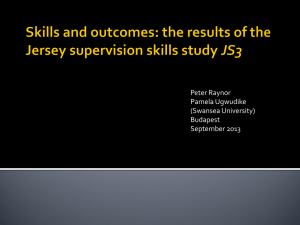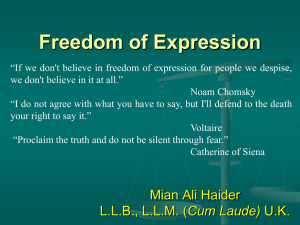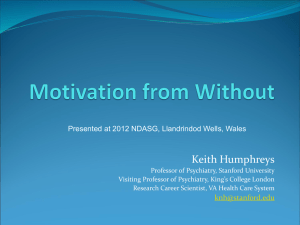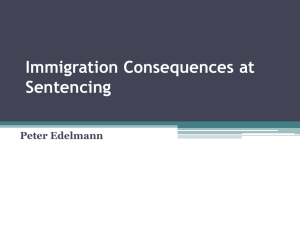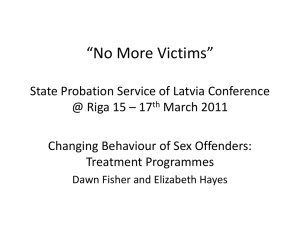An outcome evaluation of three restorative justice initiatives
advertisement
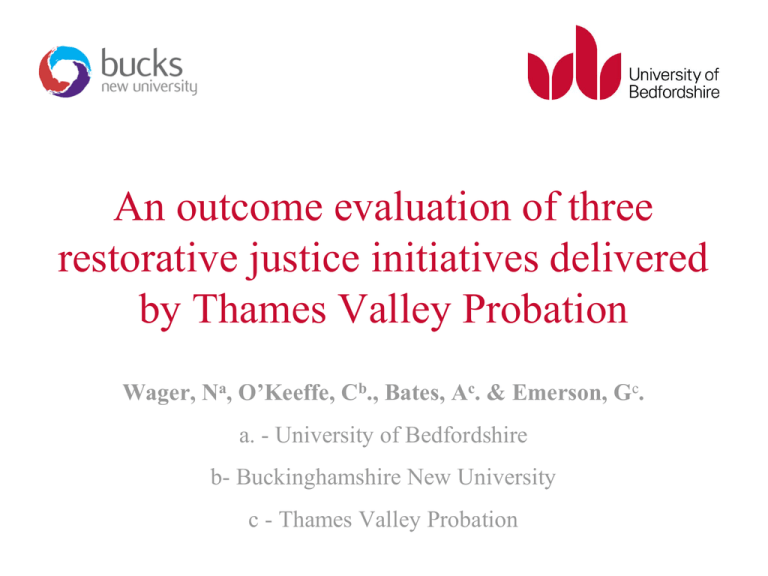
An outcome evaluation of three restorative justice initiatives delivered by Thames Valley Probation Wager, Na, O’Keeffe, Cb., Bates, Ac. & Emerson, Gc. a. - University of Bedfordshire b- Buckinghamshire New University c - Thames Valley Probation Background – (Practice) • Following their involvement in the RCT of RJ reported by Shapland et al. (2008) which evaluated the effectiveness of face-to-face conferencing, Thames Valley Probation mainstreamed RJ in community sentencing from 2005 onwards. • Principle of RJ – ‘victim-centred’ – necessitated offering victims choice of level of participation • Thus three levels of victim engagement • Face-to-face conferencing • Receiving a letter of apology • No contact – offender to engage in victim-empathy training • Recognised need for evaluation – ‘does mainstreaming RJ and offering victim choice impact on public safety?’ I.e. Do victim empathy work and sending letters of apology lead to increases in risk for reconviction. • But – victim choice and implications for the evaluation design Background – (empirical) • Between 2001 and 2004 Shapland et al. (2008) conducted a multisite, randomised-controlled trial (RCT) for the Ministry of Justice, in which Thames Valley Probation, as part of the Restorative Justice Consortium (RJC), participated by delivering RJ conferences involving adult offenders and victims. • The RJC contributed 728 cases to the study with 50% were referred to conference. • Thames Valley contributed two separate RCTs, one of violent offenders prior to release from a custodial sentence and the other of offenders who received community sentences. • The findings indicated that face-to-face conferencing reduced the rate of reconviction in relation to the control groups. • Importantly, the findings that none of the evaluated interventions were associated with an increase risk in offending. Aims • To examine the ‘treatment effects’ of the RJ initiatives as opposed to the effect of RJ in sentencing. • To determine whether each of three different restorative justice initiatives employed within a probation setting reduced the risk of recidivism in relation to that predicted by the offenders’ OGRS2 scores. • To ascertain whether the alternative forms of restorative justice work (i.e. victim-empathy work and constructing a letter of apology) demonstrated an equivalent risk for reconviction as conferencing. • To investigate the impact of the three initiatives on reconviction in relation to risk band category and offence type • To determine whether reconvictions following an RJ sentence evidence a reduction in harm 4 Method: A risk-band analysis of a single-site, multipathway RJ intervention programme run by Thames Valley Probation. Involves the comparison of the rate at which particular groups of offenders reoffended in relation to the average expected rate of reconviction for the group. • 254 offenders case progression files (85% males) – aged 16-63 • This included all offenders who were given an RJ element in their sentence from Sept 2007-Sept 2011 • Analysis conducted Sept 2012 – at least one year follow-up Expected risk for recidivism – Offender Group Risk Scale- 2 score (OGRS) – provides an actuarial indication of the likelihood of recidivism within a 2 year time frame -expressed as a percentage Allocated interventions and nature of the offences • Letter of apology – n = 102 • Victim-empathy work – n = 64 • Conference – n = 51 • Index offences: • Irresponsible behaviour (harmful but lacked criminal intent)- 14 • violent offences – 172 • Property offences – 52 • Violent + property - 16 • Non – completers – 36: 254 (transferred, revoked, breached, AWOL) University of Bedfordshire September 2006 6 OGRS2 and the data-set • OGRS2 – predicts likelihood of reconviction within a two year time frame from data of sentence. • Analysis of the whole sample which included probationers with between a 12 month and four year follow-up. • Those under two years might underestimate reconviction rates • Those over two years might overestimate reconviction • BUT – the average duration until reconviction was 5 months – (range between 2 weeks and 13 months) – all but one probationer offended within one year. University of Bedfordshire September 2006 7 Data coding • Data drawn from: • OAYSys (Offender assessment system) • PCN (Police National Computer • ICMS (the integrate case management system) • Reconviction - any crime committed that lead to an official disposal – police caution, reprimand, conviction etc. – Only reconvictions that occurred after the RJ intervention were recorded in this analysis • Reduction in harm – first two authors independently coded after comparing the details of the index and subsequent offences: equivalent, less harm or more harm • e.g. –less harm – racially aggravated assault – traffic offence University of Bedfordshire September 2006 8 Risk Bands • NOMS classification system using OGRS-2 • 1-24 – low risk • 25-49 – medium risk • 50-74 – high risk • 75+ - very high risk • All offenders within each risk band had their OGRS summated and the average was computed for each risk band and this value was then compared with the actual proportion of offenders within that band who were reconvicted. University of Bedfordshire September 2006 9 Comparison of actual vs expected rate of reconviction for RJ completers in each of the different risk categories Low Risk (n = 40) Medium Risk (n = 74) High Risk (n = 69) Very High Risk (n =31) Expected Rate Actual rate of of reconviction Reconviction (average of the OGRS2 scores) Percentagepoint reduction in risk Chi-Squared calculation to determine whether this is a significant reduction in risk 16.4% (n = 6.6) CI 8.8- 32.0 37.5% (n = 27.8) CI 27.7 – 49.2 60.6% (n = 41.8) CI 49.1 - 71.5 83.9% (n = 26) CI 67.4 -92.9 8.9% C2 = 2.35, df = 1, p =.12 (ns) 24.0% C2 = 17.26, df = 1, p <.005 41.8% C2 = 21.45, df = 1, p <.001 42.0% C2 = 40.30, df = 1, p <.001 7.5% (n = 3) CI 2.6 – 19.9 13.5% (n = 10) CI 7.5 – 23.1 18.8% (n = 13) CI 11.4 - 29.6 41.9% (n = 13) CI 26.4 – 59.2 Non-Completers Low Risk (n = 3) Medium Risk (n = 6) High Risk (n = 12) Very High Risk (n = 16) Expected Rate of Reconvictio n 20.7% (n = 0.6) CI 6.1 – 79.2 35.8% (n = 2.1) CI 9.0 - 70.0 62.7% (n = 7.5 ) CI 35.0 – 83.0 84.4% (n = 13.5) CI 60.5 – 94.7 Actual rate of reconvictio n 0% (n = 0) CI 0 – 56.2 16.7% (n = 1) CI 3.0 - 56.4 33.3% (n = 4) CI 13.8 – 60.9 50.0% (n = 8) CI 28.0- 72.0 %-point reduction in risk 20.7% Chi-Squared calculation to determine whether this is a significant reduction in risk C2 = 0.715, df = 1, p = ns 19.1% C2 = 1.380, df = 1, p = ns 29.4% C2 = 4.325, df = 1, p <.038 34.4% C2 = 14.33, df = 1, p <.0005 Reduction in recidivism by RJ Type Letter (n = 103) Victim Empathy (n = 63) Conference (n =50) Expected Rate of Reconvictio n (average of the OGRS2 scores) Actual rate of Percentagereconviction point reduction in risk 46.3% (n = 47.7) CI 37.3 - 56.2 47.3% (n = 29.8 ) CI 35.8 – 59.7 50.5% (n = 25.3) CI 36.6 – 63.4 17.5% (n = 18) CI 11.4 – 25.9 14.3% (n = 9) CI 13.7 - 33.9 24.0% (n = 12) CI 14.2 - 37.0 Chi-Squared calculation to determine whether this is a significant reduction in risk 28.8% C2 = 27.07, df = 1, p <.005 33.0% C2 = 27.55, df = 1, p <.005 26.5% C2 = 14.15, df = 1, p <.005 Type of RJ Intervention Letter of Apology Victim-Empathy Work Conference Observed rate Predicted rate of of reconviction reconviction Observed rate Predicted rate of of reconviction reconviction Observed rate Predicted rate of of reconviction reconviction 8.3% (1:12) 14.3% (1:7) Low Risk 4.8% (n = 40) (1: 21) 15.9% (n = 3.3) % point reduct 11.1% Medium Risk (n = 74) 12.8% (5:39) % point reduct High Risk (n = 69) % point reduct Very High Risk (n = 31) % point reduct 37.3% (n = 14.5) 8.6% 9.5% (2:21) 24.5% 33.3% (9: 27) 61.4% (n = 16.6) 84.9% (n = 12.7) 64.9% 39.7% (n = 8.3) 9.1% (2:22) 59.6% (n = 13.1) 21.4% (3:14) 83.4% 26.3% 35.1% (n = 4.9) 13.7% 10.0% (2:20) 50.5% 57.1% (4:7) 17.0% (n = 1.2) 2.7% 30.2% 28.1% 20.0% (3:15) 16.9% (n = 2) 60.4% (n = 12.1) 50.4% 66.7% (6:9) 82.4% 15.5% Reduction in recidivism by offence type Offence category Expected Rate of Reconviction (average of the OGRS scores) Actual rate Percentage Chi-Squared calculation of re -point to determine whether this conviction reduction is a significant reduction in risk in risk Irresponsible behavior which could or did lead to harm (n =3) 35.0% 0 100% c2 = 1.615, df = 1, p = .21 (ns) Violent offence (n = 48) Property offence (n = 11) Violence + property offence (n = 5) 46.8% (n = 22.46) 20.8% (n = 10) 55.5% c2 = 12.990, df = 1, p <.001* 55.1% (n = 6.06) 45.5% (n = 5) 17.4% c2 = 0.425, df = 1, p =.52 (ns) 41.6% (n = 2.08) 40.0% (n = 2) 3.9% c2 = 0.005, df = 1, p = .95 (ns) (n= 1.05) Offence Type Type of RJ Intervention Letter of Apology Irresponsible behaviour (n = 13) % point reduct Violent Offence (n = 149) Predicted rate of reconviction Observed rate of reconviction Predicted rate of reconviction Observed rate of reconviction Predicted rate of reconviction 0% (0:7) 30.9% (n = 2.2) 0% (0:3) 43.3% (n = 1.3) 0% (0:3) 42.3% (n = 1.3) CI 0 – 35 CI 8.2- 64.0 CI 0 – 56 CI 6.2 -79.2 CI 0 – 56.1 CI 6.0- 77.4 16.9% (12:70) 30.9% 45.0% (n = 31.5) 11.5% (6:51) 43.3% 46.8% (n = 23.9) 17.9% (5:28) 42.3% 47.1% (n = 13.2) CI 10.6–27.6 CI 34.6-57.3 CI 5.0 - 23.4 CI 34.1–60.5 CI 7.9 -35.6 CI 30.1-64.9 23.5% (4:17) 28.1% 57.8% (n = 9.8) 60.0% (3:5) 35.3% 68.6% (n = 3.4) 43.8% (7:17) 29.2% 60.8% (n = 10.3) CI 9 – 47.3 CI 36.0-78.4 CI 23.1-88.4 CI 30.2- 96.4 CI 21.6- 64.0 CI 38.2- 80.4 25.0% (2:8) 34.3% 45.3% (n = 3.6) 0% (0:3) 8.6% 24.0% (n = 1.6) 0% (0:3) 17.0% 32.3% (n = 0.97) CI 7.2-59.1 CI 19.2 -73.3 CI 0 - 56 CI 13.3- 84.2 CI 0 - 56 CI 6.2-79.2 % point reduct Property + Violent Offence (n = 14) % point reduct Conference Observed rate of reconviction % point reduct Property Offence (n = 39) Victim-Empathy Work 20.3% 24% 32.3% Nature of the index offence and reduction in harm Equivalent harm Irresponsible Behaviour No Less harm More harm reconviction 0 0 0 14 0% 0% 0% 100.0% Violent Offence 5 2.9% 17 9.9% 7 4.1% 143 83.1% Property Offence 5 10 6 31 9.6% 19.2% 11.5% 59.6% 0 3 0 13 0% 18.8% 0% 81.3% Property and Violent Offence Designation of RJ Intervention by Offence Type Letter of apology The proportion of offenders in each offence group who participated in a particular RJ intervention Irresponsible Violent Property Mixed behaviour offence offence property and violent offence 50.0% 41.3% 32.7% 50% (n = 71) (n = 17) (n = 8) (n = 7) Victim empathy work 21.4% (n = 3) 30.2% (n = 52) 9.6% (n = 5) 18.8% (n = 3) Conference 21.4% (n = 3) 16.3% (n =28) 32.7% (n=17) 5.9% (n = 3) Noncompleters 7.1% (n = 1) 12.2% (n = 21) 25.0% (n = 13) 12.5% (n = 2) Key Findings • Overall 23.3% of the probationers were reconvicted • But just 18% of RJ completers were reconvicted in comparison to 35% of non-completers – both proportions are far less than predicted. • 37% of property offenders who completed RJ were reconvicted • 18% of violent offenders • Low risk and property offenders demonstrate the greatest reduction in risk from writing a letter of apology • Medium risk – victim-emapthy work • High risk / violent offenders - conferencing University of Bedfordshire September 2006 18 • Of the reconvictions -64% were for a less serious crime • 25% committed a more serious crime • All three RJ intervention were associated with harm reduction • Non-completers who reconvicted demostrate equivalence in the level of harm • Their offences were more likely to be propoerty related University of Bedfordshire September 2006 19 Conclusions • The results of the analysis give the probation confidence that: • They have managed to maintain quality of delivery sufficient to lead to a reduction in reconviction • The choice offered to victims which has led to the preparation of letters of apology and the undertaking of victim empathy work is ‘safe’ and does no harm and leads to a reduction in the rate of reconviction • The delivery of a face to face conference remains the process which has the greatest impact on reconviction. • The implications of this for practice- to seek face-to-face meetings where possible, but to have confidence in the alternatives as a means of ensuring victim choice.
